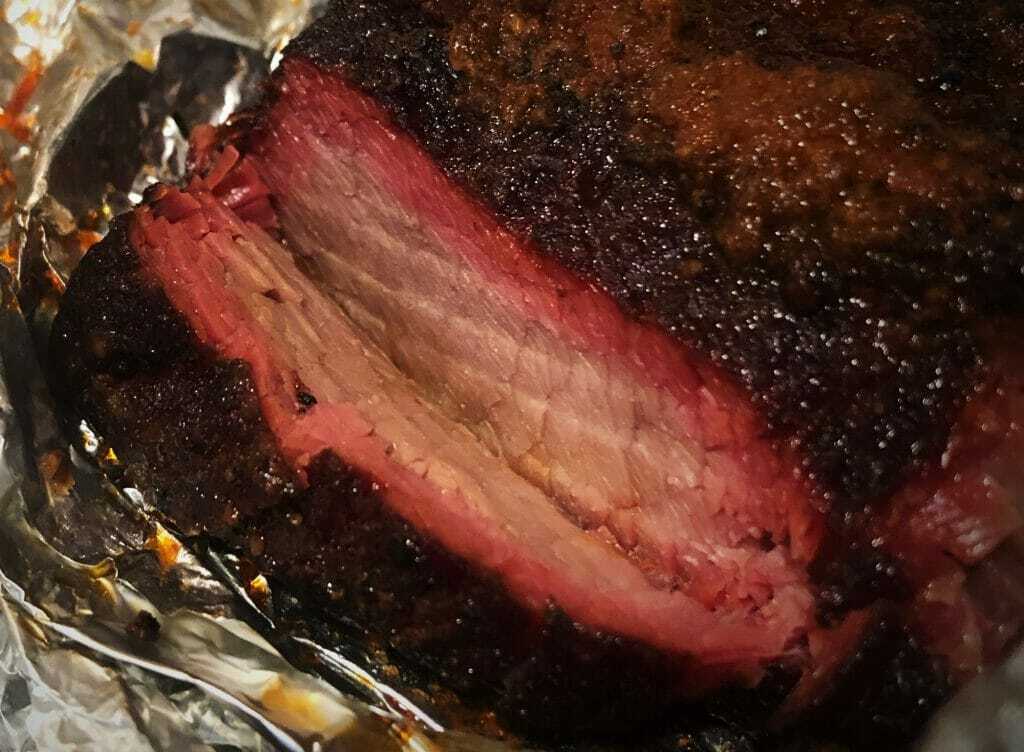guest blog post by Darcy Maulsby
Ever have a sudden flash of insight that’s as compelling as a baby seeing its reflection in a mirror for the first time? You’ll never experience the world the same again.
It happened to me a few years ago when I was taking a class in Des Moines to become a certified Kansas City Barbecue Society judge. The instructor, a tall, strapping Texan, conveyed two things I’ve never forgotten. I can still hear the contempt in his voice as he informed us, “You Iowans think milk is a spice!” I also marvel at his unbridled enthusiasm for beef brisket.
Of all the meats we were learning to judge (including ribs, pork and chicken), I couldn’t figure out why brisket would top his list. True, I’d only had a few briskets in my life, but I hadn’t been impressed. In my experience, brisket was dry. Tough. Blah.
But I snapped to attention when the instructor began passing a plate of smoked beef brisket. I couldn’t ignore the savory aroma. I didn’t want to look away from the rich bark (the spicy, smoky crust) enveloping those juicy brisket slices. I did want my table mates to hurry up so I could helpful myself these mesmerizing morsels of meat.
Finally, I took that first bite. Oh my. Suddenly I knew exactly what my instructor was talking about. This brisket was unlike any other I’d ever tasted. Fork-tender. Succulent. Exquisite.
I knew my culinary life would never be the same, now that I’d experienced this delectable revelation.
Hungry yet?

Let’s dig into some beef brisket basics, just in time for May Beef Month, so you, too, can experience the magic and enjoy this beefy goodness in all its glory.
Brisket — The Cut
Since the brisket comes from the animal’s lower chest, an area that is used for movement, this primal cut of meat can be tougher than other beef cuts. This also makes the brisket an ideal cut for cooking low and slow in the smoker, the oven or in a slow cooker.
Best Beef for Brisket
A great brisket starts with high-quality beef with good marbling (intra-muscular fat). As your brisket cooks for many hours, you’re rendering the fat into oh-so-good flavor.
Seasoning a Brisket
It’s hard to go wrong with a mix as simple as coarse pepper, kosher salt, and garlic powder. These flavors enhance the meat, allowing the robust, beefy flavor to shine.
How to Cook Brisket
I have a Traeger pellet grill/smoker, so that’s how I like to smoke meats. I often use fruit woods like apple for smoking meats, although it’s fun to experiment with other flavors, too, like mesquite.
You don’t need a smoker, however, to prepare a great brisket. You can create a memorable brisket meal in your oven. Try this Texas Oven-Roasted Beef Brisket (https://www.foodnetwork.com/recipes/texas-oven-roasted-beef-brisket-recipe-1915431).
If you do have a smoker, however, feel free to try this Smoked Brisket recipe I adapted from Traeger. Infuse your brisket with wood-fired flavor, and forget coming back for seconds. You’ll be coming back for thirds!
Smoked Brisket
Ingredients
1 (12- to 14-pound) beef brisket
1-1/2 cups beef broth
Rub
2 tablespoons garlic powder
2 tablespoons onion powder
2 tablespoons paprika
2 teaspoons chili powder
1/3 cup kosher salt
1/3 cup black pepper, coarsely ground
Directions
When ready to cook, set the temperature to 225 degrees Fahrenheit, and preheat, lid closed, for 15 minutes.
For the rub: mix together garlic powder, onion powder, paprika, chili pepper, kosher salt, and pepper in a small bowl. Season brisket on all sides.
Place brisket, fat side up, on grill grate. Cook brisket until it reaches an internal temperature of 160 degrees Fahrenheit, about 3 to 4 hours.
When brisket reaches internal temperature of 160 degrees, remove meat from grill. Double wrap meat in aluminum foil, and add beef broth to the foil packet. Return brisket to grill, and cook until it reaches an internal temperature of 204 degrees, about 3 hours more.
Once finished, remove brisket from grill, unwrap from foil, and let meat rest for at least 15 minutes.
*Note: cook times will vary, depending on the set temperature and ambient temperatures.
